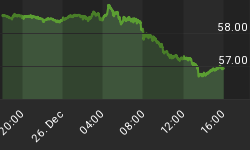This is the final installment of our series on developing a trading strategy.
In part 1, I looked at a common trend following strategy of buying the S&P500 when prices are above the 40 week moving average and selling the S&P500 when prices are below. This is a simple, easy to manage strategy, but often times (in trading), simpler is better. As it turns out over the test period, the strategy did not beat buy and hold S&P500 and it did not improve upon the equity curve draw down. In the end, one has to seriously question what benefit to their portfolio this simple trend following strategy offers.
Certainly ease of execution has to be considered, and with this in mind, maybe there is some filter that can improve the strategy's return and draw down. In other words, maybe there is a filter that will get rid of the bad trades and preserve the good ones.
In part 2, we looked at one filter and this was our indicator constructed from the trends in gold, crude oil, and yields on the 10 year Treasury bond. See figure 1, lower panel. When these trends are collectively strong, equities underperform. When these trends are not extreme, equities outperformed significantly. As we showed in part 2, a strategy employing this indicator alone out performed buy and hold S&P500 by 1.6 times, but it still left us with an equity curve draw down of 46%. This certainly is too high, but as we will show in this article, the combination of a trend following strategy (from part 1) with the filter (from part 2) will improve our draw down without sacrificing the gains.
Figure 1. Composite Indicator/ weekly
I concluded part 2 with the following comments:
While far from perfect, our filter appears to have the potential to improve our simple moving average system. Furthermore, a moving average, being price sensitive, will always keep us on the right side of the trend. Therefore, this will likely improve the function of the filter and help us avoid the bear markets. In part 3 of this series, it is my expectation that synergies of the moving average system and filter will be realized when combined together.
So this brings us to part 3 or this article, and here we will combine the trend following strategy of part 1 with the filter we used in part 2 into a single easy to follow strategy.
The data set is weekly data of the S&P500 with the first trade initiated in 1985.
The buy signal requires the 1) S&P500 to above the 40 week moving average; and 2) the indicator in figure 1 to be below the extreme line (i.e., weak trends in gold, yields on the 10 year Treasury, and crude oil).
The sell signal occurs if 1 of 2 things happen: 1) the indicator in figure 1 moves above the extreme line; or 2) price of the S&P500 has closed below the 40 week moving average for 2 consecutive weeks.
All trade signals are executed at the weekly close; slippage and commissions are not considered. There were no stop losses utilized.
So how does our new combination strategy perform?
Since 1985, there were 57 trades producing 1666 S&P500 points. Buy and hold produced 978 S&P500 points. 58% of the trades were profitable; this is a nearly 50% improvement over the trend following strategy in part 1 where only 40% were profitable. Equity curve draw down has been reduced to 15%, which is extraordinary over buy and hold.
The equity curve for this strategy is shown in figure 2.
Figure 2. Equity Curve
The maximum adverse excursion graph is shown in figure 3, and this will give us an idea of how each trade performed. We note that the majority of winning trades (green carets) had an MAE of less than 4%; this is to the left of the blue line. There was one trade that had an excessive drawdown and this was in 1998. As it turns out, this was the only trade with a loss greater than 5% - pretty amazing.
Figure 3. MAE Graph
Ok, what have we done? In part 1, we looked at simple trend following strategy, and what we found is that it underperformed buy and hold S&P500 and it did not improve any of our risk metrics. In part 2, we looked at a filter to improve the quality of our signals, but because there was no price sensitive filter (i.e., a moving average) to keep us on the right side of the trend, draw downs remained high. In part 3, we combined both tools (trend following plus filter) and we get a strategy that easily beats buy and hold and has extraordinary risk characteristics. In essence, we have developed an easy to follow trading strategy.
Lastly, let me mention that as of this past Friday this strategy is on a buy signal. Prior to that the strategy was out of the market and on a sell signal from March 12, 2010.
















